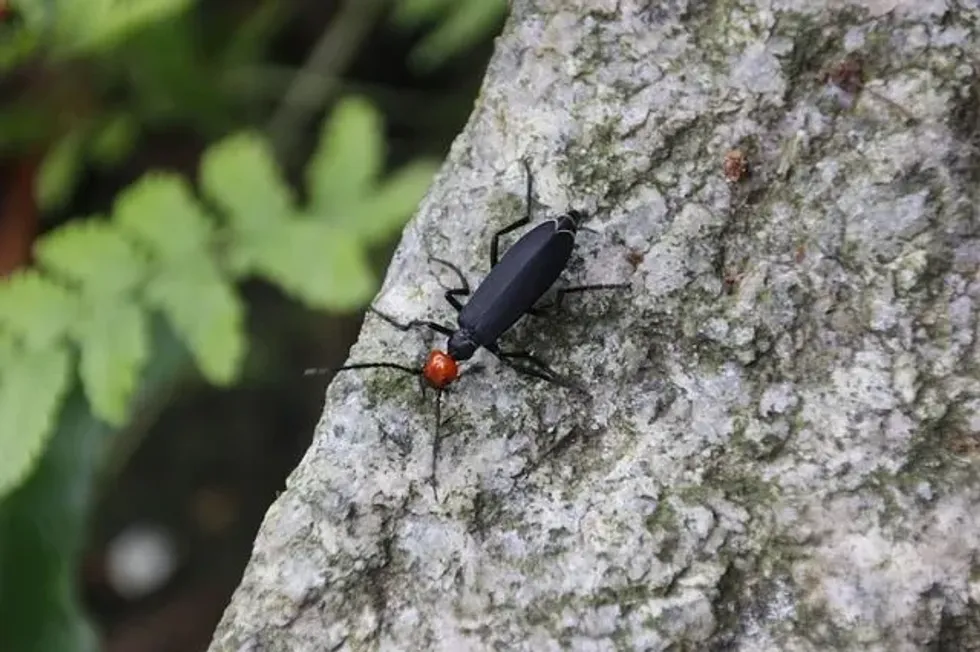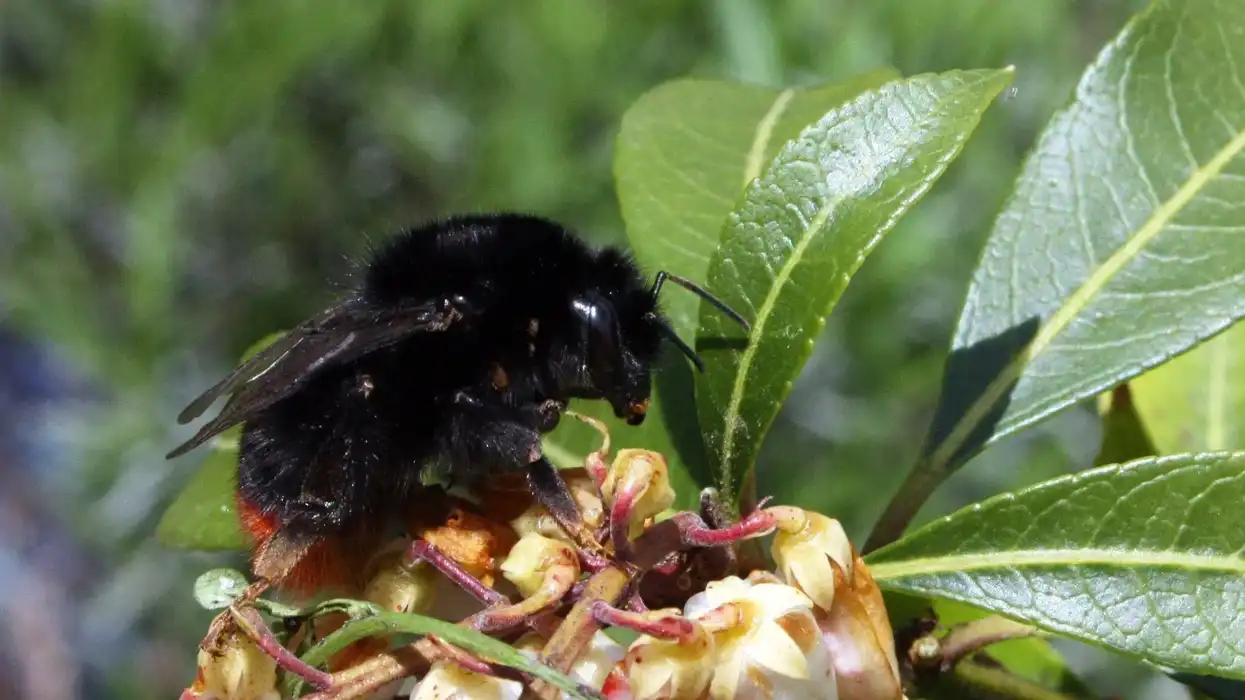The black blister beetle, also known as Epicauta pennsylvanic, is commonly found in Western countries, especially in the United States. The beetles belong to the Meloidae family.
The black blister beetle is quite small in size and the average length of one is 1-1.5 in (2.5-4 cm). Even though these little insects are small, they are known to be one of the most harmful farm pets. Blister beetles are generally found in grasslands and farms.
Blister beetles primarily prey on the leaves of plants, pollen, and nectar but their larvae are insectivores and feed on grasshopper eggs and parasitoids. These small blister beetles are very bright in color and also have yellow spots on their body.
However, they are very toxic as these insects secrete cantharidin, a poisonous blistering agent. When someone comes into contact with this type of beetle, cantharidin can also cause inflammation in several parts of the body such as the mouth, eyes, and digestive tract.
Apart from humans, blister beetles are highly poisonous to horses, sheep, and cattle. Studies have also revealed that cantharidin produced by these beetles could be deadly to domesticated animals.
Keep on reading to learn more interesting facts about the black blister beetle. If you want to know more exciting information about different animals, check out the tiger beetle and Asian lady beetle.
Black Blister Beetle Interesting Facts
What type of animal is a black blister beetle?
Blister beetles are beetles that are black with yellow stripes. These insects are known for their cantharidin, a poisonous blistering agent. These beetles are generally quite small in size.
What class of animal does a black blister beetle belong to?
Blister beetles belong to the Insecta class and the Epicauta genus. The blister beetle belongs to the family of one of the largest species, Meloidae, which are known for their toxic cantharidin.
How many black blister beetles are there in the world?
The exact population of blisters beetles is scientifically unknown as of now but these insects are commonly found in the countries of North America such as the United States and Canada. A recent study reveals that more than 2500 species of the striped blister beetle belong to the family of Meloidae.
Out of these, around 120 species of striped blister beetles are found in Florida, a state in the United States.
Where does a black blister beetle live?
The striped blister beetle is found in various countries of North America such as the United States, Canada, Mexico, and the West Indies. These blister beetles are also found in England and a few European countries.
What is a black blister beetle's habitat?
A black blister beetle is usually found in grasslands. We can also find these insects in forests and swamps. As they prey on plants and grasshopper eggs, this species can easily be spotted in agricultural fields.
Who do black blister beetles live with?
Unlike other insects, the blister beetle does not live a solitary life. As these insects primarily prey on plants, they form small groups known as swarms. Also, many domesticated animals are attacked by the venom called cantharidin that blister beetles secrete.
How long does a black blister beetle live?
Black blister beetles go through a process called metamorphosis which means their life is generally divided into four stages. In this process, the pupal stage lasts for 13 to 14 days and the overall development of some of the blister beetles takes more than three years.
How do they reproduce?
Like other beetles, the process of blister beetles mating is the same. The process starts with females releasing their pheromones.
This is the chemical released by female blister beetles to attract males. Primarily, adults come closer to each other through courtship behavior, and after mating, the female beetle lays her eggs either in the soil or near a habitat with grasshoppers and bees.
The main purpose of laying eggs near the nests of bees is that their larvae can prey on the eggs of small bees and grasshoppers.
A female blister beetle lays around 3500 to 4000 eggs at a time during the late summer. After laying the eggs, the process of metamorphosis starts in which the larval stages start to occur in winter while the pupa stage occurs in the spring season.
The pupal stage and the larval stages last for two weeks and one month respectively. The overall development of a blister beetle takes more than three years.
What is their conservation status?
As of now, we do not have any information regarding the conservation status of this species as many organizations such as the International Union for Conservation of Nature have listed this species as Not Evaluated which means the numbers of these beetles are not a concern.
Several studies also reveal that there are more than 2500 species of the blister beetle epicauta that belong to the family of Meloidae. Out of these 2500 species, around 120 species are found alone in the state of the United States, Florida.
Over the years, these blister beetles are also found in England, the West Indies, Mexico, and several parts of Europe.
Black Blister Beetle Fun Facts
What do black blister beetles look like?
Blister beetles can easily be found in several colors apart from black such as ash gray and metallic green. Some of them have yellow stripes while some have orange stripes on their body.
These insects are very small in size but are very dangerous as well. They have wider heads and a soft and flexible pair of wings. These beetles are active during both, day and night and are most attracted to lights.
How cute are they?
Black blister beetles are attractive beetles and are primarily found in black color with yellow stripes. These blister beetles are also found in several other colors such as ash gray, metallic green, and bright yellow.
Apart from this, these beetles are quite small in size which some people may find attractive but the presence of a highly toxic chemical called cantharidin is not a cute characteristic of this beetle.
How do they communicate?
Like other species of the Meloidae family, these beetles also have low vision and use the sense of smell to communicate with each other. Generally, female black beetles release a chemical called pheromones to attract male beetles.
Studies also reveal that through the help of a sense of smell and the ability to touch, these insects try to communicate and find each other.
How big is a black blister beetle?
Blister beetles are quite small in size and the average length of a beetle is 1-1.5 in (2.5-4 cm). These insects are also bigger than other beetle species.
Blister beetles are ten times bigger than carpet beetles which are commonly found in households. Also, beetles belonging to the genus Epicauta are eight to nine times bigger than the Scydosella musawasensis.
How fast can a black blister beetle fly?
Generally, the exact speed of black blister beetle is being studied by scientists but these insects are indeed quite active during the day and night. These beetles fly in swarms or groups and the speed is determined by the speed of the wind.
When they smell others, they fly high and join the group. They are also attracted to lights.
How much does a black blister beetle weigh?
The weight of a black blister beetle is not known at the moment but these beetles are bigger than several species of beetles such as Scydosella musawasensis, carpet beetles, and weevils of the order Coleoptera.
What are the male and female names of the species?
There are no specific names given to male and female beetles of this species. People generally refer to them as a male blister beetle and a female blister beetle.
What would you call a baby black blister beetle?
No particular name has been given to refer to a baby black blister beetle, but when the insect is in the early stages, it is called a larva.
What do they eat?
Blister beetle adults are primarily herbivores whereas the larva of this insect prey on other insects. Adults prey on flowers, plants, and crops such as alfalfa, soybean, and potatoes while the food habits during the larval stage are different. The larva prey on the eggs of grasshoppers and small bees.
Are they poisonous?
These beetles are quite small in size but at the same time very dangerous. These insects secrete cantharidin, a poisonous blistering agent. When someone comes into contact with a beetle, cantharidin can cause blisters on human skin and inflammation in several parts of the body such as the mouth, eyes, and digestive tract.
Apart from humans, blister beetles are highly poisonous to horses, sheep, and cattle. Studies have also revealed that the cantharidin produced by these beetles can be deadly to domesticated animals, especially to horses as they sometimes consume hay or other food along with these small-sized beetles.
Would they make a good pet?
These insects are one of the most beautiful creatures on the planet but people generally do not consider them to be pets. They become quite annoying during the summer season as they harm crops and plants such as alfalfa.
Also, adults have a highly toxic chemical called cantharidin which could cause harm to humans and especially kids. It is not suggested to have them as pets as they mainly belong to the wild.
Did you know...
In countries such as the United States, beetles are quite common. During the harvesting season in the semiarid regions of the country, these beetles toxicate several plants such as alfalfa, an important forage crop despite the use of modern harvesting methods. Also, beetles with this highly toxic cantharidin are found in Colorado, a state in the United States.
Why are they called blister beetles?
As the name suggests, these beetles have a poisonous blistering agent called cantharidin in their body. The chemical is highly toxic and can cause severe damage to humans like blisters on the skin and animals when they come into contact. A few animals do die after consuming hay or food along with these beetles.
What does a blister beetle do?
Generally, adult blister beetles do not like human interaction but are quite harmful to both humans and the environment. If any living being comes into close contact with them, these beetles usually secrete the highly toxic chemical, cantharidin.
This chemical causes blisters on the human skin while is deadly for animals. People generally treat them as unwanted pests as they damage flowers, crops, and plants as they form swarms and then fly.
Here at Kidadl, we have carefully created lots of interesting family-friendly animal facts for everyone to discover! Learn more about some other arthropods including ghost moth or gulf fritillary butterfly.
You can even occupy yourself at home by drawing one on our false blister beetle coloring pages.










